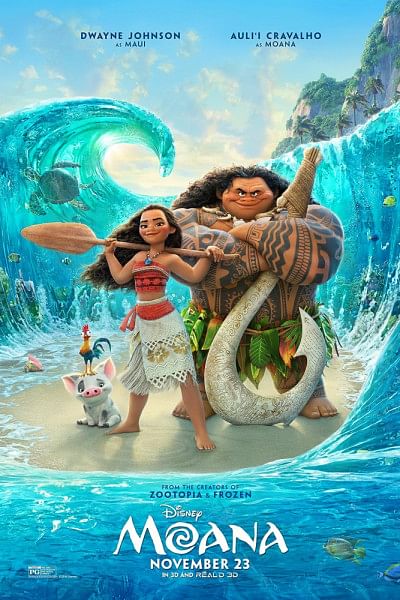Disney’s ‘Moana’: An offensive portrayal of Polynesian culture and mythology

As Disney has announced the release of "Moana 2"—hitting theatres on November 27, I couldn't help but feel the need to write my views on the original "Moana" (2016). In my opinion, the film is unfortunately a product that has used Polynesian culture and mythology to its own capitalistic benefit and is clearly told from the perspective of the white man, thereby lacking authenticity.

"Moana" explores the story of an adolescent Pacific islander named Moana who goes out into the unknown on a quest that allows her to transition from the protected life of a princess into a courageous voyager or wayfarer. She defeats all odds—with some help from the Polynesian demigod Maui and the ocean itself, who is a character in the plot as well—to restore peace and balance to a dying world and save the people of the fictional island of Motunui. However, beyond the heartfelt narrative, the animation film is replete with offensive images and portrayals that make it a problematic product of neo-cultural colonialism.
For starters, the most obvious colonial aspect of the tale is the presentation of the Kakamora, a race of people who are literally depicted as coconuts. How is it that certain people are depicted as "coconut people" (a racial slur against Pacific islanders), look very much non-human, and speak an unintelligible language portrayed as savages? Is this a colonialist view of a certain race or tribe from the Pacific Islands?

It reminds me of Rudyard Kipling's poem "The White Man's Burden," which justifies colonisation, and demonises and infantilises the non-white peoples as "half-devil and half-child". As a viewer, I cannot help but feel that since the Kakamora are untouched by whiteness and all things white, including the English language, Christianity, etc, they are portrayed in an offensive manner that screams imperialism and racial stereotyping.
Moreover, I felt that Maui, the shape-shifting demigod— despite being quite an entertainer with his moving tattoos and musical performances— was portrayed in an offensive manner, given that he is not just all muscle, unlike the voice actor Dwayne Johnson; rather quite bulky, in an unattractive way, according to societal standards, at least for the sake of the argument.
New Zealand MP Jenny Salesa of Tongan heritage posted a photo of Maui on her Facebook, captioning him "half pig, half hippo." This, according to Doug Herman's research, "perpetuates offensive images of Polynesians as overweight." It seems unfair to portray him in such a way, especially since he is seen as a Polynesian hero who has fished islands out of the sea, snared the sun to slow it down in its passage, and performed many other such extraordinary feats.

Hercules, the Greek demigod, is portrayed as having just about the most perfect body in Disney's "Hercules"— someone who exudes machismo. How is it that Disney decided to portray the white Hercules as the pinnacle of physical prowess and depict the non-white Maui as someone who is best described as being "thick"—especially when it comes to his upper body, which makes him look disproportionate and therefore caricaturesque—whereas both are mythical demigods? It is almost as if the white makers of this Polynesian story have fashioned Maui in a way that won't allow him to look sexually desirable or godlike. Maui is also represented as quite a dimwit at times, making him even more comical and thus more offensive.
While it is not the story of Maui, it feels disrespectful for Disney to have portrayed him as a comic relief rather than a cultural figure who is revered by the Polynesians.

And finally, while I am no expert of Polynesian music, I am certain it is not the kind of Western music that has been composed for "Moana," and my belief was further strengthened by looking for Polynesian music on YouTube. There is a certain ring to songs like "You're Welcome" that makes them very Western and very Disney-esque. It is almost as if the remnants of colonisation are, still, playing a part by introducing non-Polynesian music in a seemingly Polynesian story— something that can be best described as neo-imperialism or cultural imperialism, which is an attempt to impose certain elements of the dominant culture (in this case, Western music) on a native culture.
Unsurprisingly, the film's directors, Ron Clements and John Musker, are white, and it is almost as if "whiteness" prevents artistes, such as film directors, from portraying the non-white peoples with a non-colonial lens. This is not the first time that these directors have proved this to be true because they are also the same directors who made Disney's "Aladdin," which has been rightly accused of perpetuating Orientalist stereotypes of the Middle East and Asia.

 For all latest news, follow The Daily Star's Google News channel.
For all latest news, follow The Daily Star's Google News channel. 









Comments